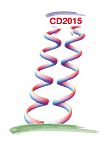Speaker
Thomas Wolkanowski-Gans
(Goethe-Universität Frankfurt am Main)
Description
A way to understand the light scalar sector of hadron physics is by applying a type of dynamical generation in which additional resonances arise as companion poles from quark-antiquark seed states by incorporating mesonic loops at the level of S-wave propagators [1−3]. Along this line, we first repeat and complete the calculations of previous works of Tornqvist and Roos (TR) and Boglione and Pennington (BP), where the resonance a0(980) appears as an additional pole of the propagator of the predominately quark-antiquark state a0(1450). Both works were important as they demonstrated the feasibility of the idea of companion poles – however, we show that in TR, the same as in BP, the pole width of both states is too large by a factor of 2 when compared to data, and that in BP the pole mass of a0(1450) is too large of about 400 MeV. We then construct an effective model Lagrangian for a0(1450) coupling to pseudoscalar mesons with both non-derivative and derivative interactions, and calculate its propagator. We demonstrate that it is indeed possible to obtain two poles, one for a0(980) and one for a0(1450), in good agreement with data, thus showing that the mechanism of companion poles can deliver not only qualitative but also quantitative correct results.
References
1. N. A. Tornqvist, Z. Phys. C 68, 647 (1995).
2. N. A. Tornqvist and M. Roos, Phys. Rev. Lett. 76, 1575 (1996).
3. M. Boglione and M. R. Pennington, Phys. Rev. D 65, 114010 (2002).
Primary author
Thomas Wolkanowski-Gans
(Goethe-Universität Frankfurt am Main)
Co-authors
Prof.
Dirk H. Rischke
(Institut für Theoretische Physik, Goethe-Universität Frankfurt am Main, Frankfurt am Main)
Dr
Francesco Giacosa
(Institut für Theoretische Physik, Johann Wolfgang Goethe-Universität, Frankfurt)

